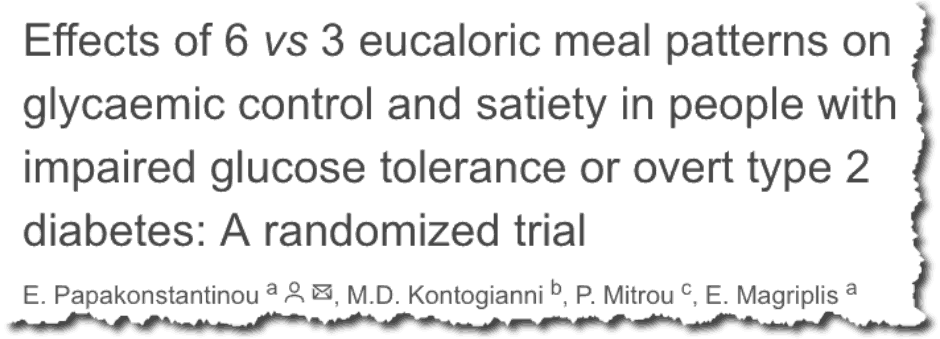
[cmamad id=”20612″ align=”center” tabid=”display-desktop” mobid=”display-desktop” stg=””]
One of these can fix blood sugar problems, while the other just makes you fatter – here’s how it all works
—-Important Message—-
These men claimed they found a natural cure to cancer, brain disorders, and many other “incurable” diseases…
And now they’re all dead and their research has been confiscated…
Over the past few years, over 90 health researchers died under mysterious circumstances…
What if they were working on a breakthrough that stimulates the body’s immune system to devour cancer cells?
Or maybe they were they a threat to Big Pharma’s $85 billion a year in PROFITS?
What if there is evidence that they died from foul play?
Click here to see what may be a cover-up – what do you think of this?
————–
6 small meals a day OR 3 big ones?
A new study shows that meal frequency can improve blood sugar regulation – and make us thinner.

These researchers coordinated their study at the Agricultural University of Athens. They published their results in the Journal of Diabetes and Metabolism.
The study involved men and women between the ages of 19 and 65.
The participants ate either three times per day or six times per day.
After 12 weeks, the participants swapped places: Those who were eating three meals per day switched to six and vice versa.
Both diets contained the same amount of calories – 1,900 kcal.
“In this randomized crossover study, subjects with impaired glucose tolerance followed a similar diet of 3 or 6 meals/day.”
[cmamad id=”20613″ align=”center” tabid=”display-desktop” mobid=”display-desktop” stg=””]
The study found that participants with type 2 diabetes had improved blood sugar levels when they ate more frequently.
Two hours after eating, blood sugar levels were decreased in the group eating six meals per day.
“In type 2 diabetes, HbA1c and plasma glucose were lower at 2 hrs post-oral glucose tolerance test with 6 vs 3 meals.”
HbA1c is a test used in diabetes. It is a marker of blood sugar levels over a longer time period.
Lower HbA1c in the six-meal group indicates that blood sugar levels are more stable over the long term with more frequent meals.
Eating six meals per day also decreased hyper-insulinemia – showing that more frequent meals can help regulate insulin.
“The 6-meal intervention improved hyperinsulinemia in IGT-A subjects and hyperglycemia in IGT-B subjects.”
(IGT means impaired glucose tolerance.)
People in the IGT-B group also have impaired glucose tolerance – but their blood glucose levels are higher at 30-90 minutes after the glucose tolerance test.
The study did not find any significant changes in body weight or physical activity during the experiment.
So the results are very likely due to meal frequency.
“Body weight and physical activity levels remained stable throughout the study.”
Eating six meals per day was also associated with decreased hunger.
This was independent of how impaired the blood glucose levels were at the beginning of the study.
Everyone ate the same total amount of food.
“In all three groups, subjective hunger and desire to eat were reduced with 6 vs 3 meals/day.”
The researchers saw the effect of higher meal frequency on blood sugar control for obese participants in the study with type 2 diabetes.
“Our study shows that 6 vs 3 meals a day can increase glycemic control in obese patients with early-stage type 2 diabetes.”
The results also show benefits for people with prediabetes or type 2 diabetes.
“6 vs 3 meals a day can increase glycemic control and may perhaps stabilize postprandial glucose regulation in prediabetes subjects.”
The improvement in HbA1c is an indicator that there may be long-term benefits from this meal frequency…
However, another test, the HOMA-IR, did not show improvements.
“There were no differences in HOMA-IR or plasma lipids between interventions.”
The HOMA-IR calculates multiple factors relating to blood sugar and insulin regulation.
Doctors and researchers use this to assess insulin resistance and the health of the beta cells. (Beta cells produce insulin in the pancreas.)
Increasing meal frequency may not turn out to be a cure for diabetes.
But this study shows that altering meal frequency while consuming the same amount of calories can help regulate blood sugar and insulin.
The fact that increasing meal frequency also decreases appetite means that this is a useful strategy for dealing with symptoms of type 2 diabetes – or pre-diabetes.
You should see a healthcare professional about diagnosing and treating blood sugar and insulin dysregulation.
—-Important Message—-
Men with diabetes: How to restore your erections
It turns out that men with diabetes have high levels of endotoxins – and these endotoxins kill erections.
When they lower their endotoxins, men with diabetes can perform very well.
And, as a side benefit, they can stop their symptoms cold – and often get rid of all their medication (with their doctor’s blessing) – and say “I used to be a diabetic, but I’m not anymore.”
Does this sound far-fetched?
Well, guess what. A famous Harvard researcher named Dr. Steven Shoelson demonstrated this, and yet the medical community purposely ignores it.
Here is the simple 30-cent remedy that reverses diabetes symptoms
——–

https://www.sciencedirect.com/science/article/pii/S1262363618300776
https://www.livestrong.com/article/430464-how-many-meals-should-you-eat-a-day-to-gain-weight/
https://www.menshealth.com/nutrition/a19539881/how-to-gain-weight/
https://www.verywellfit.com/sample-meal-plan-for-a-weight-gaining-diet-2507759
Off course, but your main focus would be to increase the intake of calories. But not everybody's body is the same. A body's needs and its ability to put on weight or lose it is dependant on various factors. Genes play a role here and so does the kind of energy you use.Maybe that is the reason, people with a sedentary lifestyle are susceptible to put up weight faster than those who are activity oriented. However, diet and the type of food you eat plays an important role here. Some people even if they are regularly exercising and lifting weights, seem to have problems in gaining weight.But does that mean you now have a one-way ticket to eating all the fatty Cheeseburgers and French fries you want?That could actually be unhealthy and cause disorders in the long run. For healthy weight gain, choose high-calorie foods that are rich in nutrients. Pay attention to increasing the calorie intake than increasing the amount of food you eat. A high calories food plan can include brown rice, whole grain bread, potatoes, peas, bananas, cheese, beans, nuts, and seeds. Increase the use of calorie boosters like nut butter and milk products. Foods like Legumes, Avocados and a balanced diet of Fruits & Vegetables also help pack the body with the needed vitamins and minerals along with your protein needs.Increase the intake of milk products. Rice and Potatoes are a good source of energy too. They add carbs and calories. Salmon and Oily fish are nutritious and are a good source of Omega-3 fatty acids and provides high-quality protein for your body needs. Also, look at Dried fruits as a healthy alternative.
But start slowly.
Some individuals can suffer from side effects, from increasing their calorie intake overnight. Upset stomach, constipation, and heartburn can occur. According to a certified Weight expert, look at increasing 250 extra calories every two to three days. Know your body and know what suits your palate.
Here is a sample 6 meals a day plan ( 2500 calorie diet ) you can follow.
Morning – You could start your day with a Whole Grain ready to eat cereal serving. This can be mixed with milk accompanied with 2 tablespoons of nonfat dried milk powder. Add a slice of Banana or maybe a glass of Orange juice to go with it.
Mid-morning snack – Six crackers of Whole Grains with 1 ounce of Cheddar cheese. Top it up with a serving of Apple and Cream.
Lunch – Grilled salmon with two – three ounces of mixed greens. Add to it 1/3 cup of chickpeas + 10- 12 chopped pistachios or Almonds + 2 tablespoons of Olive oil + some low-fat yogurt. If you are a food lover, you can add some Brown bread to it and top it with some cheese.
Mid-afternoon snack – Go for smoothies. A cup of blueberries,1/2 cup of strawberry + 1 cup of soymilk or regular milk +2 tablespoons of peanut butter + A tablespoon or two of organic honey can be perfect.
Dinner - Cook a cup of mix veggies + 4 ounces of sliced chicken + Using 2 tablespoon of vegetable oil + a cup of brown rice or a Loaf of Brown bread + A Glass of Fresh Fruit juice or Raw Broccoli sprouts to add the right fiber and protein needs.
Look forward to increasing the Calories intake every month, so that you could boost your weight gain incrementally.

Leave a Reply